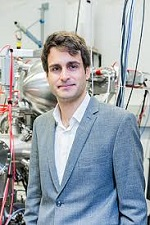Extreme Ultraviolet Metaoptics
This webinar is hosted By: Short Wavelength Sources and Attosecond/High Field Physics Technical Group
07 November 2024 10:00 - 11:00
Eastern Time (US & Canada) (UTC -05:00)
Extreme ultraviolet (EUV) light enables attosecond physics and nanoscale semiconductor lithography. Unfortunately, all materials absorb it due to its large photon energy, and no transmissive optics exist. In this webinar, Marcus Ossiander will introduce how we overcome this lack of optical elements using ultrathin metasurfaces.
These novel optics comprise millions of high-refractive-index nanopillars on flat substrates. The small extent of these building blocks allows researchers to mold the spatial phase of light on the sub-wavelength scale, an ability that currently revolutionizes the handling of visible light. However, for the EUV spectrum, no high-refractive-index materials exist. Marcus will introduce how holes in silicon can act as guiding structures for EUV light, how we can exploit this fact to create metaoptics for 50-nm radiation, how we manufacture and characterize such elements, and the possible applications enabled by this first universal transmissive optics technology for the EUV.
What You Will Learn:
• State of the art of optics for the extreme ultraviolet
• Metasurface basics
• How metasurfaces can be adapted to the extreme ultraviolet spectrum
Who Should Attend:
• Graduate students and researchers in attosecond science
• Graduate students and researchers in extreme ultraviolet optics
• Graduate students and researchers in metaoptics interested in novel spectral regimes
About the Presenter: Marcus Ossiander from Graz University of Technology/Harvard University
 Marcus Ossiander explores the use of metasurfaces in attosecond microscopy at the Graz University of Technology. His research is funded by an ERC Starting Grant and an FWF Start Grant. Marcus is also a research associate at Harvard University, where he develops metasurfaces for ultrashort laser pulses and cavity applications. Before, Marcus investigated the attosecond dynamics of carriers in solid-state materials and gases at the Max-Planck Institute of Quantum Optics.
Marcus Ossiander explores the use of metasurfaces in attosecond microscopy at the Graz University of Technology. His research is funded by an ERC Starting Grant and an FWF Start Grant. Marcus is also a research associate at Harvard University, where he develops metasurfaces for ultrashort laser pulses and cavity applications. Before, Marcus investigated the attosecond dynamics of carriers in solid-state materials and gases at the Max-Planck Institute of Quantum Optics.
